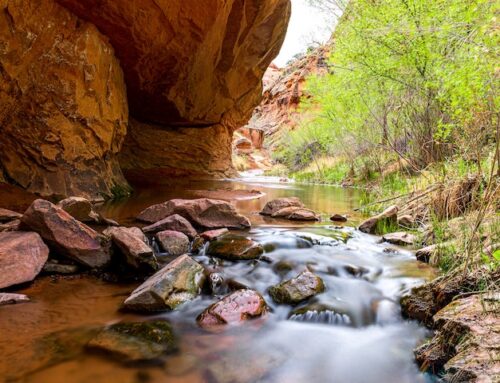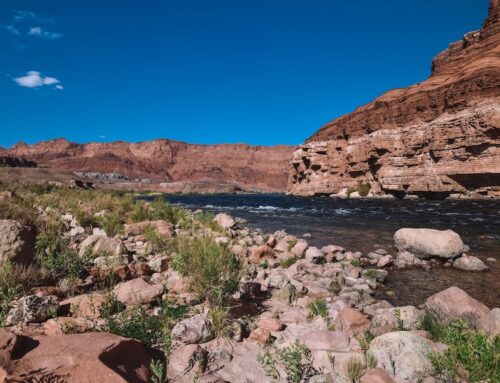In April 2024, the Colorado Plateau Foundation staff, and allies rafted the Colorado River through the Grand Canyon. Communications and Outreach Manager Darrien Benally and Strategies and Partnership Associate Rebekah Chattin reflected on the experience and shared what they learned.
“The ones who have known the Colorado River the longest”
Rebekah Chattin’s Reflection
Before this experience, I had been reading about the Colorado River history, the water law surrounding the river, and the Plateau tribe’s struggle to obtain water rights. As we currently know, so much of the Colorado River’s history and laws have been shaped for years by business people , lawyers, state officials, scientists, and federal agencies. The river is quantified into acre-feet, dividing the river among basins, states, businesses, and individual parties. Frequently left out of these conversations and allocations are Colorado Plateau tribes, the ones who have known the Colorado River the longest.
During the trip, I spent time alone in the river, reflecting on everything I had seen. Standing in the cold water, I looked up at the canyon walls to see the impressions the river had left throughout the millions of years carving the Grand Canyon. It occurred then that the concept of water law, acre feet, allocations, and wet vs. paper water rights was only a tiny portion of the river’s long life but has changed it dramatically.
I remember reading the Navajo name for the Colorado River is Bits’íís Nineez, which means River of Long Life Span and is one of the sacred rivers to the Navajo People. I wondered how many lawmakers, lawyers, business people, commercial ranchers, etc., understood the river’s force and sacredness the way Native peoples do. How many of them have even felt the force of the current and the shock of the river’s cold water?
Plateau tribes tied to the river have understood its significance and power for longer than these individuals. I heard stories from CEO Jim Enote, Zuni, of our ancestors farming throughout the canyon and how their livelihoods revolved around the Colorado River. I witnessed the history of the Canyon that went beyond the years of legal domestication of the river. I saw the connections of my culture and other Plateau cultures to the River that transcended the concepts of ownership or allocation.
When we think of water law- the quickly approaching expiration of the Colorado River Compact, climate change, and new water settlements with some Plateau tribes beginning to circulate through Congress; we must remember and honor the relationship Plateau tribes have had with the river. Plateau tribes have had their relationship with the river severed through legal means and forced removal. The first remedy for this relationship is to give the tribes their long-awaited water rights and support tribal initiatives leading the way to secure access to this precious resource.
“Visit with intention”
Darrien Benally’s Reflection
Under cloudy skies and a cool breeze, we unload the bus from Flagstaff, AZ. Our group has arrived at Marble Canyon, where inflatable yellow oar boats line the shore of the Lee’s Ferry boat launch. I’m in a place I’ve never been before, but I feel right at home. To the emerald waters of the Colorado River, I offered tadadiin- yellow-corn pollen. Sprinkling the fine powder over the glittering surface of the water, I ask for permission to travel peacefully and set my intentions for the visit. The CPF staff and our partners regathered and set out on the river to learn about one of the Plateau’s most critical resources, the Colorado River.
I quickly learned that traversing the river is not to be taken lightly. The rapids will have you clinging to the raft for dear life, and the river’s icy waters take your breath away. Shí Nali asdzáán (Navajo for paternal grandmother) always told me we visit a place such as the Grand Canyon with intention. We never come to the sacred place solely for recreational purposes. Her words repeated in my mind as I marveled at the canyon’s walls boasting vermillion-colored layers streaking into green-gray limestone and shale.
My intention for the trip was to learn about the threats to the canyon on a deep level and form my relationship to the river. I could read about the numerous threats, including overuse of the river by agriculture and municipal uses, climate change, and contamination from uranium mining. Still, the information was too abstract without a relationship with the water.
As days passed on the river, I realized I felt at home in the canyon. I began to understand that I am connected to the Colorado River through ancestral stories and traditional knowledge sharing. Along the trip, we saw sites like the Nankoweap Granaries, an ancestral pueblo site carved into the cliffside, and the Hopi Salt mines where Hopi men gather salt for ceremonial purposes. Others on the trip experienced the canyon and the river for the first time and sometimes felt out of place. Native peoples life myself have always maintained a connection with the river and canyon through songs and ceremonies.
The Grand Canyon is a powerful place full of ancient knowledge that allowed ancestral Puebolean people to establish once-thriving communities within its bounds. The Havasuapi people still maintain their ancestral homelands at the bottom of the canyon, defending the place against its many threats. The Navajo, Hopi and other tribes continue to fight legal battles for their rights to access and use the river to carry out their way of life on the Colorado Plateau.
I understood what was at stake for the river if threats to it continued unchecked. Currently, the Colorado River supplies at least 35 million people, and over 70% of the river is allocated to agriculture. A 2016 study by the Bureau of Reclamation found that climate change is impacting snowpack in the upper river basin, leading to variable river flows throughout the year, which threaten hydropower operations and agriculture. Being physically present in a place I’ve previously only read about, the threats became tangible.
Not only is the loss of a resource at stake for millions who rely on it, but connections to Native ancestry, knowledge, and relationships to the river are also at stake. In late 2023, the Pinyon Plain Mine began operations near the South Rim of the Grand Canyon, threatening potable water resources, including springs. Earlier this year in 2024 a construction permit for the Big Canyon Dam was denied, a project that would introduce a hydroelectric dam into the Little Colorado River gorge. The proposal threatened the Confluence, where the Colorado River and Little Colorado River merge, and the emergence place for the Hopi and Zuni people who have ties to the canyon dating back thousands of years. Above the Confluence on the rim, Navajo families graze sheep and continue their ancestral practices. Such stories and practices are vital to tell and honor if we shift how we use the Colorado River and think of it as an entity to be respected instead of a resource to exploit.



